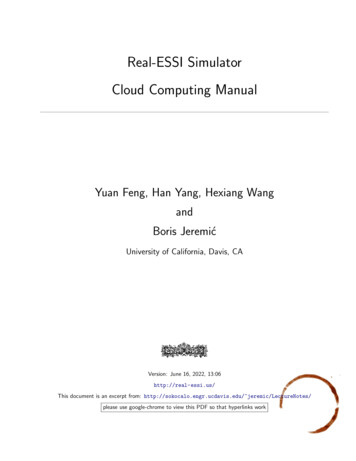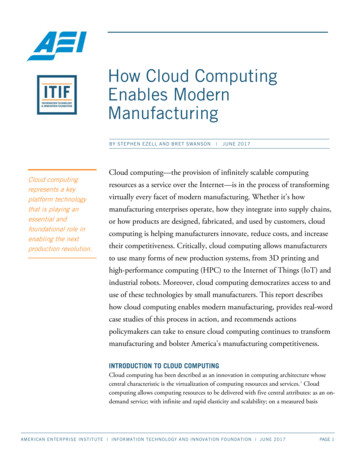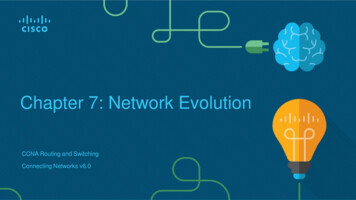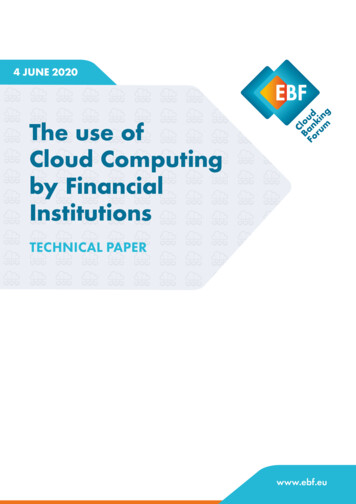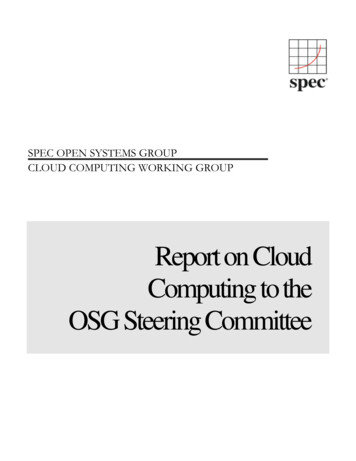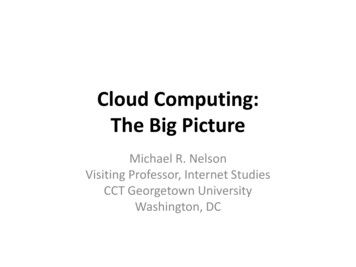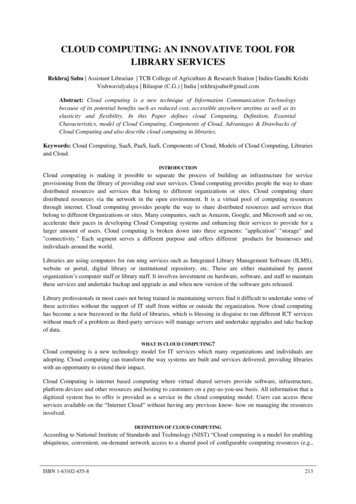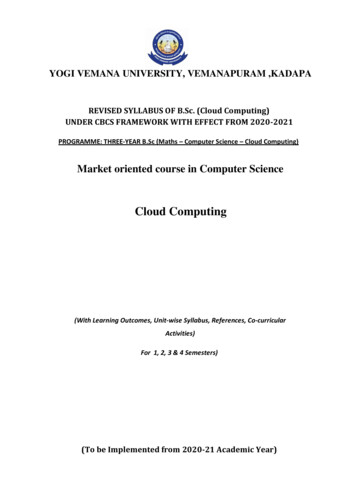
Transcription
YOGI VEMANA UNIVERSITY, VEMANAPURAM ,KADAPAREVISED SYLLABUS OF B.Sc. (Cloud Computing)UNDER CBCS FRAMEWORK WITH EFFECT FROM 2020-2021PROGRAMME: THREE-YEAR B.Sc (Maths – Computer Science – Cloud Computing)Market oriented course in Computer ScienceCloud Computing(With Learning Outcomes, Unit-wise Syllabus, References, Co-curricularActivities)For 1, 2, 3 & 4 Semesters)(To be Implemented from 2020-21 Academic Year)
Cloud ComputingSemesterPaperSEMESTER I ISEMESTER II IISEMESTERIIIIIIIVSEMESTERIVVSubjectFIRST YEARBasics of Cloud Computing(Google,Amazon, IBM, Red hat,Microsoft, Sales force)Cloud Computing LabCloud Computing ServicesHrs. CreditsIAESTotal4325751002423025507550100HTML / CSS and Java Script 2LabSECOND YEARApplication development on 4Cloud ComputingCloud based Application2DevelopmentLab20505032575100205050APEX & Visual forceProgrammingAPEX and Visual force LabBusiness IntelligenceBusiness Intelligence Lab43257510023223202505075505010050
I YEAR I SEMESTERBasics of Cloud ComputingObjectiveThe student will be knowing Cloud Computing basics and its services which includeSaaS, PaaS, and IaaS. It also deals with different types of cloud such as Google, Amazom,IBM, Redhat, Microsoft and Salesforce.comOutcome:The student will1. Get acquainted with the term Cloud computing.2. Understand various types of free and commercial clouds.3. Understands various types of cloud services like SaaS. PaaS and IaaS.4. Know how the Cloud Computing is changing software industry.UNIT-IComputer Networks, basics of networking, Architectures of networking, topologies, types ofNetworks ,LAN,WAN,MAN, Network Components, Protocols, Communication aspects,basics of internet.UNIT-IIClient-Server Computing, Cluster Computing, Grid Basics, Distributed Computing.Introduction to Cloud Computing, Introduction to Software as a Service (SaaS),Infrastructure as a Service (IaaS), and Platform as a Service (PaaS).UNIT- IIIUnderstanding Google Cloud, Google Apps, Google Compute Engine (GCE) ,Google AppEngine. Amazon Services, Amazon Web Services, Amazon EC2. IBM Cloud Computingwith its PaaS, IBM as Saas and IBM as IaaS.UNIT-IVRed hat Cloud Computing with its PaaS. Microsoft Azure Cloud Computing ServiceWindows azure platform Services, Windows Azure storage, Windows Azure fabrics.UNIT-VSalesforce Cloud Computing Services Pass, SaaS and IaaS.Heroku and Force.com as PaaS.
I YEAR I SEMESTERReferences1. Cloud Computing – An Introduction bySubuSangameswar2. Mastering Cloud Computing Paperback by Buyya (Author), Vecchiola(Author),Selvi (Author)3. Cloud Computing for Complete Beginners: Building and Scaling HighPerformanceWeb Servers on the Amazon Cloud by IkramFatahRECOMMENDED CO-CURRICULAR ACTIVITIES:(Co-curricular activities shall not promote copying from textbook or from others work andshall encourage self/independent and group learning)A. Measurable1. Assignments (in writing and doing forms on the aspects of syllabus content andoutside the syllabus content. Shall be individual and challenging)2. Student seminars (on topics of the syllabus and related aspects (individual activity))3. Quiz (on topics where the content can be compiled by smaller aspects and data(Individuals or groups as teams))4. Study projects (by very small groups of students on selected local real-timeproblems pertaining to syllabus or related areas. The individual participationand contribution of students shall be ensured (team activity))B. General1. Group Discussion2. Try to solve MCQ’s available online.3. OthersRECOMMENDED CONTINUOUS ASSESSMENT METHODS:Some of the following suggested assessment methodologies could be adopted;1. The oral and written examinations (Scheduled and surprise tests),2. Closed-book and open-book tests,3. Problem-solving exercises,4. Practical assignments and laboratory reports,
I YEAR I SEMESTER5. Individual and group project reports.6. Efficient delivery using seminar presentations,7. Viva voce interviews.8. Computerized adaptive testing, literature surveys and evaluations,9. Peers and self-assessment, outputs form individual and collaborative workCloud Computing Lab1) Creating Amazon Account to storeimages.2) Creating Google Account to store files andprograms.3) Creating IBM cloud account and access storagespace.4) Creating Microsoft Azure Account and working on AzureCloud5) Creating salesforce.com Account and working onTrailhead.com
I YEAR II SEMESTERCloud Computing ServicesObjectiveThis subject would be exploring SaaS, PaaS, and IaaS in Cloud Computing and differenttypes of clouds such as Sales Cloud, Service Cloud, Marketing Cloud, Analytics Cloud, etc.OutcomeAfter completing this subject the student would be having knowledge on benefits of beingpartof a community dedicated to success, know where to get started, connect with others, gethelp, share ideas, and collaborate.UNIT-IEco System of Salesforce.com, Leveraging our community resources and events, Stopping,Collaborating and listening, Industries and Clients.UNIT-IIVarious Clouds in Salesforce.com, Functionality, Advantages, Uses, Define Sales cloud,Service cloud, Marketing cloud, Analytics cloud, Platform and Apps, IOT and Commerce.Unit –IIIBrief overview on Marketing Cloud, Sales Cloud & Service Cloud in Salesforce.comUnit –IVHeroku and Force.com Clouds of Salesforce.com, Functional uses, Advantages, ExamplesUnit-VBrief overview on Wave Cloud, Thunder for IoT and Collaboration Cloud in Salesforce.comReferences1. Architecting the Cloud: Design Decisions for Cloud Computing ServiceModels(SaaS, PaaS, and IaaS) (Wiley CIO) by Michael J. Kavis(Author)2. Cloud Computing: SaaS, PaaS, IaaS, Virtualization, Business Models,Mobile,Security and More by Kris Jamsa(Author)
I YEAR II SEMESTERRECOMMENDED CO-CURRICULAR ACTIVITIES:(Co-curricular activities shall not promote copying from textbook or from others work andshall encourage self/independent and group learning)C. Measurable1. Assignments (in writing and doing forms on the aspects of syllabus content andoutside the syllabus content. Shall be individual and challenging)2. Student seminars (on topics of the syllabus and related aspects (individual activity))3. Quiz (on topics where the content can be compiled by smaller aspects and data(Individuals or groups as teams))4. Study projects (by very small groups of students on selected local real-timeproblems pertaining to syllabus or related areas. The individual participationand contribution of students shall be ensured (team activity))D. General1. Group Discussion2. Try to solve MCQ’s available online.3. OthersRECOMMENDED CONTINUOUS ASSESSMENT METHODS:Some of the following suggested assessment methodologies could be adopted;1. The oral and written examinations (Scheduled and surprise tests),2. Closed-book and open-book tests,3. Problem-solving exercises,4. Practical assignments and laboratory reports,5. Individual and group project reports.6. Efficient delivery using seminar presentations,7. Viva voce interviews.8. Computerized adaptive testing, literature surveys and evaluations,9. Peers and self-assessment, outputs form individual and collaborative work
I YEAR II SEMESTERHTML, CSS and Java Script Lab1.How to create an HTMLpage?2.How to create, Body,Header?3.What is the Simplest HTMLPage?4.How can i add Comment in HTML?5.What is HyperText Link?6.Can I nest tables with inTables?7.How to create CSS?8.What are Pseudo classes and what they are usedfor?9.What are the three main ways to apply CSS to a webPage?10. What is grouping and why it is usedfor?11. What is an ID Selector and how it isused?12. What is class selector how it is differ from IDselector?13. How to create Java scriptpages?
II YEAR III SEMESTERApplication Development on CloudComputingObjectiveThis subject will be exploring data structure with objects, fields, object relationships,security management, and communication templates.OutcomeAfter completing this subject the student would be having knowledge on developing anapplication through GUI.UNIT-ICreating Apps, Tabs, S Objects, Fields, Records, Data. Working on Salesforce.com ClassicInterface.UNIT-IIWorking on Various Relationships – Self Relationship, Lookup Relationship, Masterdetail Relationship, Many to many Relationship, Rollup Summery Relationship,Hierarchical RelationshipUNIT –IIIWorking with Custom components, Principles of designing Salesforce.com Projects. FilteringData through Validations of Master Data, Designing page layouts, Designing Search layouts,and Record Types.UNIT –IVSecurity Management – Data Security, Data Migration- Import Wizard/ Data Loader. SchemaSecurity/User Security, Organisation Security, Profiles, Roles, Queues, Public Groups, OWDSharing Rules and Permission Sets.UNIT-VCommunication Templates, Domain management, Working with Workflows & ApprovalsProcess, Working with Process builder.References :Practical Salesforce.com Development Without Code by Philip Weinmeister.Teach Yourself VISUALLY Salesforce.com by Justin Davis and Kristine Curington
II YEAR III SEMESTERRECOMMENDED CO-CURRICULAR ACTIVITIES:(Co-curricular activities shall not promote copying from textbook or from others work andshall encourage self/independent and group learning)E. Measurable1. Assignments (in writing and doing forms on the aspects of syllabus content andoutside the syllabus content. Shall be individual and challenging)2. Student seminars (on topics of the syllabus and related aspects (individual activity))3. Quiz (on topics where the content can be compiled by smaller aspects and data(Individuals or groups as teams))4. Study projects (by very small groups of students on selected local real-timeproblems pertaining to syllabus or related areas. The individual participationand contribution of students shall be ensured (team activity))F. General1. Group Discussion2. Try to solve MCQ’s available online.3. OthersRECOMMENDED CONTINUOUS ASSESSMENT METHODS:Some of the following suggested assessment methodologies could be adopted;1. The oral and written examinations (Scheduled and surprise tests),2. Closed-book and open-book tests,3. Problem-solving exercises,4. Practical assignments and laboratory reports,5. Individual and group project reports.6. Efficient delivery using seminar presentations,7. Viva voce interviews.8. Computerized adaptive testing, literature surveys and evaluations,9. Peers and self-assessment, outputs form individual and collaborative work
II YEAR III SEMESTERCloud based Application Development Lab1.How to CreateModel?2.How to CreateApps?3.How to createTabs?4.How to create Sobjects?5.How to createField?6.How to createRecords?7.How to create Validation rules?8.How to create pagelayouts?9.How to create RecordTypes?10. How to createUsers?11. How to createRoles?12. How to create PublicGroups?13. How to createQueues?14. How to create SharingRules?15. How to createWorkflows?16. How to create Process BuilderAutomations?17. How to use ApprovalProces?
II YEAR IV SEMESTERAPEX & Visual force ProgrammingObjectiveAfter completing this subject the student would be having knowledge on data types andoperators, understanding core concepts of apex and visual force, which includes collectionsand interfaces.Outcome:This subject will be exploring basics of programming through Salesforce.com with apexand visual force, which are programming language and framework respectively.UNIT-IData Types and Operators- Primitive, Complex, Expressions and operators, DefiningFunctions, Oops Concept- Abstraction, Encapsulation, Inheritance and PolymorphismUNIT-IIUnderstanding Apex core concepts, Developing code in the cloud Apex Developmentprocess: Learning Apex, App Quick Start, Writing Apex class, Creating a custom object,Adding the Test class,UNIT –IIICollections- List, Set, Map Working with DML Operations- Insert, Update, Upsert, Delete,Undelete and Merge, Execution flow in Apex- Exception Handling, Assertions andAnnotations.UNIT –IVInterface in Apex- Batch Apex, Schedule Apex. Working with Triggers- Trigger Syntax,Trigger Context variables, Validations and AutomationsUNIT-VIntroduction to Visual Force, Working on Visual Force components- Format Tags, InputTags, Action Tags, Output Tags and Miscellaneous Tags. Working on Various ControllersCustom controllers, Standard controllers, Extensions.References1. Apex Complete Developer Guide bySalesforce.com2. Visual Force Developer guide bySalseforce.com
II YEAR IV SEMESTERRECOMMENDED CO-CURRICULAR ACTIVITIES:(Co-curricular activities shall not promote copying from textbook or from others work andshall encourage self/independent and group learning)G. Measurable1. Assignments (in writing and doing forms on the aspects of syllabus content andoutside the syllabus content. Shall be individual and challenging)2. Student seminars (on topics of the syllabus and related aspects (individual activity))3. Quiz (on topics where the content can be compiled by smaller aspects and data(Individuals or groups as teams))4. Study projects (by very small groups of students on selected local real-timeproblems pertaining to syllabus or related areas. The individual participationand contribution of students shall be ensured (team activity))H. General1. Group Discussion2. Try to solve MCQ’s available online.3. OthersRECOMMENDED CONTINUOUS ASSESSMENT METHODS:Some of the following suggested assessment methodologies could be adopted;1. The oral and written examinations (Scheduled and surprise tests),2. Closed-book and open-book tests,3. Problem-solving exercises,4. Practical assignments and laboratory reports,5. Individual and group project reports.6. Efficient delivery using seminar presentations,7. Viva voce interviews.8. Computerized adaptive testing, literature surveys and evaluations,9. Peers and self-assessment, outputs form individual and collaborative work
II YEAR IV SEMESTERAPEX and Visual Force Lab1.How to write a Business class and Test class and how to create anObject?2.Create a Rectangle class Apexclass?3.Create a Point class Apexclass?4.Create a Bank Accountclass?5.How to write Collectionclass?6.How to write DML statements like insert, Update, delete, Undelete, merge andUpsert?7.How to implement ExceptionHandling?8.How to write Assertion andAnnotations?9.How to write TriggerClass10. How to write Batch Apexclass?11. How to write Schedule Apex class?12. How to create Visual forcepage?13. How to work on Standard Controllers and CustomControllers14. How to work on Standard listcontrollers?
II YEAR IV SEMESTERBusiness IntelligencePurposeThis subject will be exploring concepts on Wave Analytic basics, Wave DesktopExploration, Wave App Basics, Sales Wave App, and Service Wave App.ObjectiveAfter completing this subject the student will gain the knowledge of BusinessIntelligence using which they can convert raw data into pictorial format and analyse itto predict the future business.Unit-IWave Analytic basics – Exploring Wave Analytics, Setup Wave analytics,Creating wave analytic AppUnit-IIWave Desktop Exploration- Data Explorer, Analyse Data Explorer, CompareTable. Wave Mobile Exploration: Mobile Data Explorer, Mobile Explorationinterface.Unit- IIIWave App Basics: Creating Wave App basics, setting up Wave app Licenses andpermissionsUnit- IVSales Wave app – Creating and Analysing Sales wave using Wizard, Sales wave onMobilesUnit-VService Wave App – Creating Service Wave using wizard, Service wave toManage Service Load, Basic Wave Dashboard Customization.ReferencesIntroduction to Salesforce Analytics - Building Reports and Dashboards:Class Slides & Workbook for Sprd-101 by Steve Wasula (Author)
RECOMMENDED CO-CURRICULAR ACTIVITIES:(Co-curricular activities shall not promote copying from textbook or from others workand shall encourage self/independent and group learning)I. Measurable1. Assignments (in writing and doing forms on the aspects of syllabuscontent and outside the syllabus content. Shall be individual andchallenging)2. Student seminars (on topics of the syllabus and related aspects (individualactivity))3. Quiz (on topics where the content can be compiled by smaller aspectsand data (Individuals or groups as teams))4. Study projects (by very small groups of students on selected local realtime problems pertaining to syllabus or related areas. The individualparticipation and contribution of students shall be ensured (teamactivity))J. General1. Group Discussion2. Try to solve MCQ’s available online.3. OthersRECOMMENDED CONTINUOUS ASSESSMENT METHODS:Some of the following suggested assessment methodologies could be adopted;10. The oral and written examinations (Scheduled and surprise tests),11. Closed-book and open-book tests,12. Problem-solving exercises,13. Practical assignments and laboratory reports,14. Individual and group project reports.15. Efficient delivery using seminar presentations,16. Viva voce interviews.
17. Computerized adaptive testing, literature surveys and evaluations,18. Peers and self-assessment, outputs form individual and collaborative workIII YEAR V SEMESTERBusiness Intelligence Lab1.How to createReport?2.How to createDashboards?3.How to create Tabularreports4.How to create Matrixreports?5.How to create Joinedreports?6.How to create Summaryreports?7.How to add custom field formulas?8.How to create immediate reports and Scheduledreports?9.Creating Vertical Bars, Horizontal and Piecharts.10. Adding Reports toDashboards.11. How to add Tabular Report toDashboard?12. Adding Filters toReports.
IBM Cloud Computing with its PaaS, IBM as Saas and IBM as IaaS. UNIT-IV Red hat Cloud Computing with its PaaS. Microsoft Azure Cloud Computing Service- Windows azure platform Services, Windows Azure storage, Windows Azure fabrics. UNIT-V Salesforce Cloud Computing Services Pass, SaaS and IaaS.Heroku and Force.com as PaaS.




